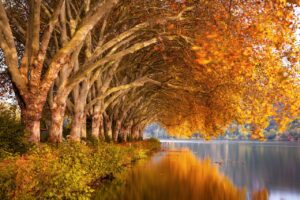No products in the cart.
Fun Facts
Fall Foliage Photography Tips
 Fall Foliage Photography Tips
Fall Foliage Photography Tips
Autumn paints the world in a kaleidoscope of vibrant reds, oranges, and yellows. These colors, synonymous with the season, beckon photographers and nature enthusiasts alike. The challenge lies not just in witnessing this spectacle but in capturing its fleeting beauty. As leaves dance to the ground, every click of the shutter must encapsulate the essence of this ephemeral wonder.
Choosing the Right Time
Timing your shoots can mean the difference between an average shot and a breathtaking capture. Aim to photograph during the golden hour—the hour just after sunrise or before sunset. This time bathes your subjects in a warm, soft light that enriches colors and adds depth to your images. Conversely, blue hour, right after sunset, can produce cool tones that lend a serene atmosphere to your photos.
The Rule of Thirds
One of the easiest ways to create balance in your images is by employing the rule of thirds. Imagine dividing your frame into a grid of nine equal parts. Position the key elements of your photo along these lines or their intersections to draw the viewer’s eye and create tension.
Finding Unique Perspectives
Don’t settle for eye level; explore your surroundings. Get low to the ground for a unique perspective that showcases the intricate details of leaves and the forest floor. Climb higher to capture sweeping vistas of autumn foliage that reveal the full spectrum of color.
Tips for Capturing Details
Autumn foliage isn’t just about wide shots of trees; it’s also about the smaller details that often go unnoticed.
Focusing on Leaves and Textures
Zoom in on the leaves to capture their intricate patterns and textures. The interplay of light and shadow can highlight their veins and edges, transforming an ordinary shot into a work of art.
The Magic of Macro Photography
Macro photography opens up a world of detail. Use a macro lens to get close to your subjects, revealing the tiny droplets of dew clinging to leaves or the rich textures that make each leaf unique. These intimate portraits of nature will add depth to your collection.
Post-Processing Your Images
After capturing your autumn masterpieces, post-processing is where the magic continues.
Enhancing Colors without Overdoing It
In post-processing, it’s tempting to oversaturate colors to make them pop. Instead, aim to enhance them subtly. Use editing software to adjust contrast and brightness, which can bring out the vibrancy of your images while keeping them looking natural.
Utilizing Software for Adjustments
Tools like Adobe Lightroom or Photoshop offer a plethora of options to refine your images. Play around with curves, sliders, and filters to find the perfect balance that showcases the beauty of fall without making it look artificial.



